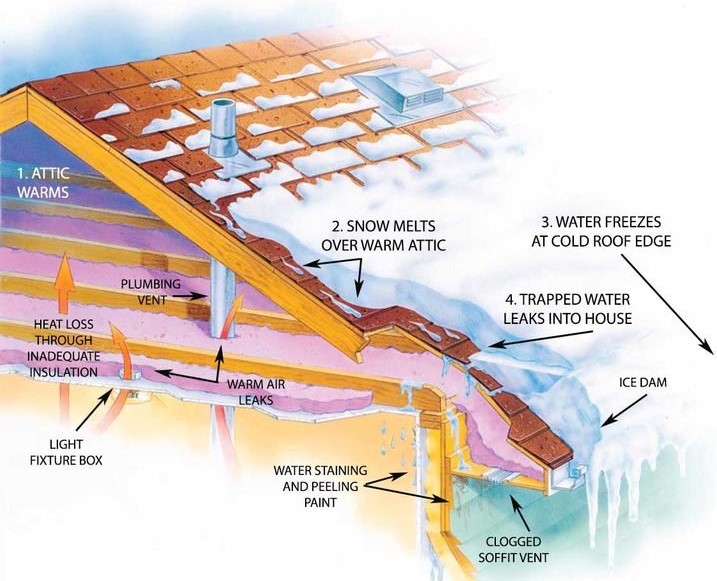Ice Dam Prevention
Although spring has sprung throughout most of New England, it’s never too early to start thinking about NEXT winter. According to our claim’s specialist, Beth Sawyer there have been a large amount of ice dam claims this winter season; an issue that is more common than one might think.
If you don’t know what an ice dam is, it’s a ridge of ice that typically forms along the edge of a roof and prevents melting snow from draining off of the roof. This in turn can create major issues, including backed up water from the ice melt leaking into your roof, which can cause water damage on the ceiling & walls. If this is not caught in time it can lead to an even bigger issue – MOLD.
Here is an infographic from Family Handy Man that helps explain ice dams better:

At this point, you’re probably wondering if your home might be susceptible to ice dams and what you can do to prevent this from happening… let us break it down for you:
Most ice dams form as a result of improper insulation and air sealing of a house. Contrary to what many people believe, a cold attic actually means no ice dams, while a warm attic means “homeowner beware.” Also, how much direct sunlight your home gets is another contributing factor. The most common areas of a home for ice dams to form are:
- In valleys of the roof
- On low-angle roofs
- Around chimneys and skylights
- At the eaves of the roof
Ice dam removal can be a pain, so the best course of action is to try to prevent them from forming in the first place. Here are some things you can do before next winter comes around.
Insulation: Most newer attics are insulated with today’s energy standards, which include fiberglass insulation. This minimizes heat escaping through the ceiling, virtually eliminating the possibility of snow melting and refreezing at the base of the roof. However, If your home was built before 1980, it probably needs more insulation. If you have an open attic, this means insulating the floor of the attic. If you have a finished second story in which a finished ceiling is directly against the roof, this means insulating the rafter spaces (in combination with ventilation). Insulation levels are recommended by geographic zones and are stated in R-values. Read more about proper home insulation here.
Ventilation: Unfortunately, insulation alone rarely is enough to prevent ice dams. It needs to be done in conjunction with better ventilation and venting your roof can be complicated. One option is to install additional roof vents and soffit vents, which can move the hot air from your attic to the exterior of your home. You also want to find and seal all of your attic bypasses. These included anywhere your walls or ceilings are penetrated (e.g., ceiling fans, ceiling lights, smoke detectors, etc.). If a hole was cut in your ceiling or wall to install something, that is a potential air leak into your attic. Other possible sources of heat venting into your attic include uninsulated HVAC ductwork, vents from clothes dryers, or improperly vented bathroom or kitchen exhaust fans. All of these heat sources should be wrapped in fiberglass insulation to reduce heat in the attic space.
Heat Cables & Heat Pucks: If updating insulation & ventilation is still not enough to prevent ice dams or maybe you just do not have the resources available to do the above, heat cables & heat pucks can be a great temporary solution. Heat cables are high-resistance wires that you mount on the roof edge in a zigzag pattern and plug into an outdoor receptacle. Ideally, they should go in spots where ice dams regularly occur and cannot be stopped by any other means. Heat pucks are small, circular discs made with calcium chloride that you can throw up on roofs to melt ice in hard-to-reach places. There are mixed reviews about heat pucks, but they might be worth a shot if you are unable to do any of the other suggestions we have mentioned.
Snow Rake your Roof: A snow rake is an aluminum scraper mounted at a right angle on a telescoping pole. The theory is if you pull the snow down off your roof, it will not be able to melt and form an ice dam. This method is most effective right after a big snowstorm, and typically can only be done on one-story homes (never use a snow rake when standing on a ladder OR get on your roof to remove the snow). This can be a simple but tedious solution, and be wary not to ruin your shingles.
We realize all this information can all be quite overwhelming. If all else fails and ice dam buildup is too much for you to handle, it might be time to call a professional. We are happy to share some names of local contractors & snow removal services if needed.
Disclaimer: Please use extreme caution if you climb onto your roof. It is important to follow the proper safety procedures — you can read more about roof safety here. Also, if you choose to make your home more airtight, it is important to check your combustion appliances for backdrafting. Remember, appliances that don’t draft properly can dump gasses into your home, including dangerous carbon monoxide. Additionally, if you choose to use heat cables, be wary that mixing water and electricity always comes with risks. Make sure to follow the manufacturer’s directions precisely and maintain the heat cables properly.
Sources:
https://www.thespruce.com/how-to-prevent-remove-ice-dams-1824696





